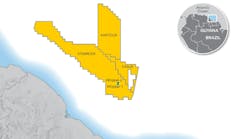Offshore staff
ABERDEEN, UK– Chevron is having to address an unparalleled combination of issues to make Britain’s first deepwater project economic.
TheRosebank oil and gas field extends over four blocks close to the median line with the Faroe Islands, said Tony McGarva, acting project manager at Chevron Upstream Europe at todays’ North Sea Outlook presentations at DOT International. The field was discovered in 2004 with six appraisal wells following by 2010. Chevron operates in partnership with OMV and DONG.
Currently the partners are looking at floating storage for the produced oil, and two options for gas export. One is a 36-km (22-mi) spur line to the new Laggan-Tormore trunkline to Shetland; the other is a 236-km (147-mi) pipeline connecting to an established North Sea trunkline system.
Chevron plans separate drill centers for the north and south reservoirs. “The waters in this region are extremely severe, giving us lots to think about,” McGarva said. “Challenges include getting vessels, helicopters, and tankers offloading out there.”
Maintenance has to be performed during the four-month summer season. Due to the harsh environment, “we need to get the corrosion protection right,” he added, “as we don’t want to be doing [repair] work when the field is in production.
“Control of the Rosebank production vessel’s stability is also key,” he said, “which means choosing the correct technology.” Chevron has studied loading motion data and the effects of a 100-year wave in the region. “The mean wave height is 4 m [13 ft], but there have been 100-ft [30.5-m] waves west of Shetland. “
TheFPSO will be 80 m (262 ft) tall with a 26-m (85-ft) wide turret, allowing it to weathervane 360°.
As for the subsurface, Chevron has been trying to identify any hazards from the seabed down to the reservoir that might impact drilling. “We need a complete assessment of the reservoir. We will be injecting water for recovery, so we need to understand the pressure envelopes.”
McGarva said the geology was unique for a UK field, with volcanic clastics on its northern flank, which continue through the Faroes and up to Iceland. The south side of the reservoir is set in a Fluvial sands system. There is no analogy anywhere in the world to this combination, he said, “so we have to build models to understand it.
“To do this, in 2010-11 we acquired ocean bottom node seismic.” The technique is effective in deepwater, he said, preventing a loss of signal and leading to clearer imaging. Results have been very satisfactory – “it has improved reservoir definition, with sharper imaging achieved compared with conventional streamer data. It has also improved velocity depth modelling for depth mapping.”
Rosebank is a four-layered reservoir, with some layers thicker than others, and with 75% of the reserves in two sands. “We are looking at drilling probably 17 wells, comprising nine producers and eight water injectors. We want to access the multiple layers with high angle wells and cased hole frac packs [for improved productivity with vertical wells, based on successful experience at Jack/St. Malo and Tahiti in the Gulf of Mexico]. We will be doing waterflood injection from day 1, with reinjection of produced water through the FPSO.”
Dolphin Drilling is constructing the newbuild deepwater semiBollsta Dolphin that will drill Rosebank’s wells. “Drilling accounts for 30% of our budget. This is a sixth-generation rig – we have taken lessons from BP and Total’s experiences operating in the region.
“This rig can handle drilling and completion. It will be able to go from the north to the south template in DP mode, which means we won’t have to bring in extra vessels for rig moves. It will also have two fully interchangeable BOPs, reducing unproductive time.”
Going through volcanics will require a diamond drill bit, McGarva added, while drilling through basalt would better suit a typical PDC drill bit. The partners are therefore considering a hybrid drill bit for all situations, which would also avoid the expense of tripping to keep coming back to the surface.
10/14/2014




